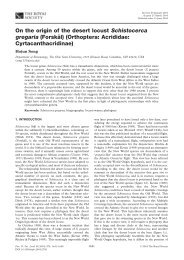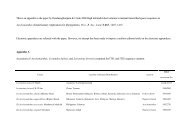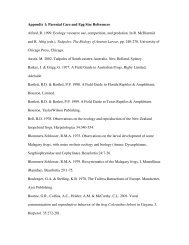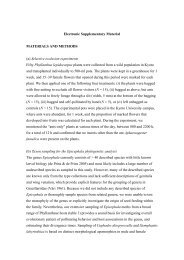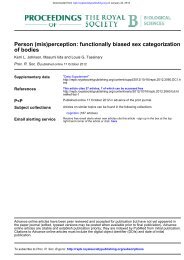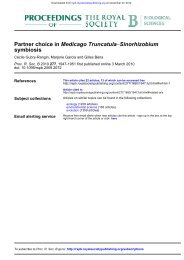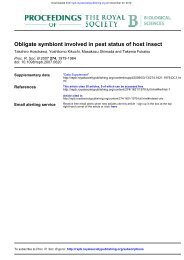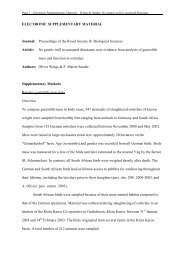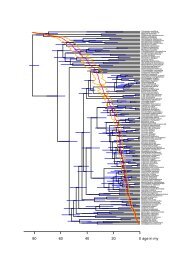Recent advances in Chinese palaeontology - Proceedings of the ...
Recent advances in Chinese palaeontology - Proceedings of the ...
Recent advances in Chinese palaeontology - Proceedings of the ...
You also want an ePaper? Increase the reach of your titles
YUMPU automatically turns print PDFs into web optimized ePapers that Google loves.
<strong>Recent</strong> <strong>advances</strong> <strong>in</strong> Ch<strong>in</strong>ese <strong>palaeontology</strong><br />
X<strong>in</strong>g Xu, Zhe-Xi Luo and Jia-Yu Rong<br />
Proc. R. Soc. B 2010 277,<br />
161-164 first published onl<strong>in</strong>e 7 October 2009<br />
doi: 10.1098/rspb.2009.1668<br />
References<br />
Subject collections<br />
Email alert<strong>in</strong>g service<br />
Downloaded from<br />
rspb.royalsocietypublish<strong>in</strong>g.org on December 18, 2012<br />
This article cites 38 articles, 8 <strong>of</strong> which can be accessed free<br />
http://rspb.royalsocietypublish<strong>in</strong>g.org/content/277/1679/161.full.html#ref-list-1<br />
Article cited <strong>in</strong>:<br />
http://rspb.royalsocietypublish<strong>in</strong>g.org/content/277/1679/161.full.html#related-urls<br />
Articles on similar topics can be found <strong>in</strong> <strong>the</strong> follow<strong>in</strong>g collections<br />
evolution (1354 articles)<br />
<strong>palaeontology</strong> (116 articles)<br />
Receive free email alerts when new articles cite this article - sign up <strong>in</strong> <strong>the</strong> box at <strong>the</strong> top<br />
right-hand corner <strong>of</strong> <strong>the</strong> article or click here<br />
To subscribe to Proc. R. Soc. B go to: http://rspb.royalsocietypublish<strong>in</strong>g.org/subscriptions
Introduction<br />
<strong>Recent</strong> <strong>advances</strong> <strong>in</strong> Ch<strong>in</strong>ese <strong>palaeontology</strong><br />
X<strong>in</strong>g Xu 1, *, Zhe-Xi Luo 2 and Jia-Yu Rong 3<br />
1 Key Laboratory <strong>of</strong> Evolutionary Systematics <strong>of</strong> Vertebrates, Institute <strong>of</strong> Vertebrate Paleontology and<br />
Paleoanthropology, Ch<strong>in</strong>ese Academy <strong>of</strong> Sciences, Beij<strong>in</strong>g 100044, People’s Republic <strong>of</strong> Ch<strong>in</strong>a<br />
2 Section <strong>of</strong> Vertebrate Paleontology, Carnegie Museum <strong>of</strong> Natural History, Pittsburgh, PA 15213-4080, USA<br />
3 State Key Laboratory <strong>of</strong> Palaeobiology and Stratigraphy, Nanj<strong>in</strong>g Institute <strong>of</strong> Geology and Palaeontology,<br />
Ch<strong>in</strong>ese Academy <strong>of</strong> Sciences, Nanj<strong>in</strong>g 210008, People’s Republic <strong>of</strong> Ch<strong>in</strong>a<br />
Discoveries are a driv<strong>in</strong>g force for progress <strong>in</strong> <strong>palaeontology</strong>. Palaeontology as a discipl<strong>in</strong>e <strong>of</strong> scientific<br />
<strong>in</strong>quiry has ga<strong>in</strong>ed many fresh <strong>in</strong>sights <strong>in</strong>to <strong>the</strong> history <strong>of</strong> life, from <strong>the</strong> discoveries <strong>of</strong> many new fossils<br />
<strong>in</strong> Ch<strong>in</strong>a <strong>in</strong> <strong>the</strong> last 20 years, and from <strong>the</strong> new ideas derived from <strong>the</strong>se fossils. This special issue <strong>of</strong><br />
Proceed<strong>in</strong>gs <strong>of</strong> Royal Society B entitled <strong>Recent</strong> Advances <strong>in</strong> Ch<strong>in</strong>ese Palaeontology selects some <strong>of</strong> <strong>the</strong> very<br />
latest studies aimed at resolv<strong>in</strong>g <strong>the</strong> current problems <strong>of</strong> <strong>palaeontology</strong> and evolutionary biology based<br />
on new fossils from Ch<strong>in</strong>a. These fossils and <strong>the</strong>ir studies help to clarify some historical debates about<br />
a particular fossil group, or to raise new questions about history <strong>of</strong> life, or to pose a new challenge <strong>in</strong><br />
our pursuit <strong>of</strong> science. These works on new Ch<strong>in</strong>ese fossils have covered <strong>the</strong> whole range <strong>of</strong> <strong>the</strong> diversity<br />
through <strong>the</strong> entire Phanerozoic fossil record.<br />
Keywords: <strong>palaeontology</strong>; evolution; paleobiogeography; morphology; Ch<strong>in</strong>a<br />
A major evolutionary pattern from <strong>the</strong> Phanerozoic fossil<br />
record is that <strong>the</strong> ext<strong>in</strong>ct l<strong>in</strong>eages <strong>of</strong> life have a far greater<br />
morphological disparity than extant life forms. Also,<br />
many more species evolved and gone ext<strong>in</strong>ct <strong>in</strong> <strong>the</strong> deep<br />
times <strong>of</strong> geological history than those liv<strong>in</strong>g today<br />
(Gould 1990; Conway Morris 1998). Palaeontology provides<br />
a unique perspective, and can make an arguably<br />
<strong>in</strong>dispensable contribution to enrich our understand<strong>in</strong>g<br />
<strong>of</strong> evolution by explor<strong>in</strong>g <strong>the</strong> greater diversity <strong>of</strong> fossils<br />
with a vast time dimension <strong>of</strong> geological history than<br />
is afforded by liv<strong>in</strong>g biological diversity.<br />
Many recent and notable palaeontological contributions<br />
to evolutionary <strong>the</strong>ory have come from Ch<strong>in</strong>a.<br />
A vast variety <strong>of</strong> fossils recently discovered <strong>in</strong> Ch<strong>in</strong>a<br />
could not be pigeon-holed <strong>in</strong>to previously known<br />
groups; this helps to expand our knowledge <strong>of</strong> <strong>the</strong> ancient<br />
biological diversity. Because many new, exquisite fossils <strong>of</strong><br />
known l<strong>in</strong>eages are exceptionally complete, <strong>the</strong>y revealed<br />
characters <strong>in</strong> unique comb<strong>in</strong>ations, some <strong>of</strong> which had<br />
not been ‘expected’ accord<strong>in</strong>g to <strong>the</strong> received wisdom.<br />
Where to place <strong>the</strong>se new fossils on <strong>the</strong> tree <strong>of</strong> life and<br />
how to <strong>in</strong>terpret <strong>the</strong>ir way <strong>of</strong> life can <strong>in</strong>fluence our<br />
understand<strong>in</strong>g <strong>of</strong> evolutionary history. For example, <strong>the</strong><br />
vetulicolians from <strong>the</strong> Early Cambrian Chengjiang<br />
biotas represent a new and dist<strong>in</strong>ctive clade <strong>of</strong> deuterostome<br />
animals (Shu et al. 2001). The surpris<strong>in</strong>g<br />
comb<strong>in</strong>ation <strong>of</strong> features <strong>of</strong> <strong>the</strong> enigmatic yunnanozoons<br />
has stimulated a long and passionate debate about <strong>the</strong>ir<br />
place on <strong>the</strong> deuterostome family tree (Chen 2008).<br />
Shu et al. (2010) reviewed <strong>the</strong> diverse deuterostomes<br />
* Author for correspondence (x<strong>in</strong>gxu@vip.s<strong>in</strong>a.com).<br />
Downloaded from<br />
rspb.royalsocietypublish<strong>in</strong>g.org on December 18, 2012<br />
One contribution to a Special Issue ‘<strong>Recent</strong> <strong>advances</strong> <strong>in</strong> Ch<strong>in</strong>ese<br />
<strong>palaeontology</strong>’.<br />
Proc. R. Soc. B (2010) 277, 161–164<br />
doi:10.1098/rspb.2009.1668<br />
Published onl<strong>in</strong>e 7 October 2009<br />
from Chengjiang with emphasis on vetulicolians and<br />
yunnanozoons, and argued that <strong>the</strong>se two groups are<br />
very basal among <strong>the</strong> diverse deuterostome l<strong>in</strong>eages.<br />
With well-preserved fossils from Chengjiang, Zhang<br />
et al. (2010) demonstrated that <strong>the</strong> l<strong>in</strong>gulate brachiopods—a<br />
premier example <strong>of</strong> liv<strong>in</strong>g fossil l<strong>in</strong>eage—have<br />
long occupied <strong>the</strong>ir dist<strong>in</strong>ctive ecological niches, from<br />
<strong>the</strong> Cambrian to <strong>the</strong> <strong>Recent</strong>.<br />
More than just <strong>the</strong> sc<strong>in</strong>tillat<strong>in</strong>g curiosities <strong>of</strong> ext<strong>in</strong>ct life<br />
forms, some <strong>of</strong> <strong>the</strong>se fossils have raised new research questions<br />
and forced us to reconsider <strong>the</strong> previous paradigms.<br />
How can students <strong>of</strong> biomechanics and functional morphology<br />
develop new models to account for <strong>the</strong> fly<strong>in</strong>g<br />
function <strong>of</strong> four-w<strong>in</strong>ged pre-avian <strong>the</strong>ropods and birds<br />
(Xu et al.2003; Zhang & Zhou 2004; Chatterjee & Templ<strong>in</strong><br />
2007)? New fossils challenge <strong>the</strong> traditional hypo<strong>the</strong>sis <strong>of</strong><br />
tetanuran <strong>the</strong>ropod manual digits and promise to solve <strong>the</strong><br />
long-debated problem <strong>of</strong> avian digital homologies<br />
(Xu et al. 2009). Contrary to <strong>the</strong> prevail<strong>in</strong>g idea <strong>of</strong> <strong>the</strong><br />
1970s that <strong>the</strong> mammalian tribosphenic molar was a s<strong>in</strong>gular<br />
evolutionary <strong>in</strong>novation, Ch<strong>in</strong>ese fossils suggest that tribosphenic<br />
molars evolved homoplastically <strong>in</strong> several l<strong>in</strong>eages<br />
(Wang et al. 1998; Luo et al. 2001, 2007; Luo 2007).<br />
New Jurassic mammals capable <strong>of</strong> swimm<strong>in</strong>g and glid<strong>in</strong>g<br />
suggest that <strong>the</strong>y <strong>in</strong>vaded diverse ecological niches <strong>in</strong> <strong>the</strong><br />
d<strong>in</strong>osaur-dom<strong>in</strong>ated ecosystem (Ji et al. 2006; Meng et al.<br />
2006). So how did such <strong>in</strong>teraction <strong>in</strong>fluence <strong>the</strong> terrestrial<br />
ecosystem? What are <strong>the</strong> palaeoecological implications <strong>of</strong><br />
<strong>the</strong> earliest-known angiosperm plants that have turned out<br />
to be aquatic (Sun et al. 1998, 2002)?<br />
Several research areas on Ch<strong>in</strong>a’s fossils and biostratigraphy<br />
have attracted attention from <strong>the</strong> broader<br />
communities <strong>of</strong> scientists <strong>in</strong> earth science and biology,<br />
such as <strong>the</strong> studies <strong>of</strong> <strong>the</strong> Neoproterozoic animal<br />
embryos, earliest known metazoans and <strong>the</strong> Ediacaran<br />
Received 14 September 2009<br />
Accepted 14 September 2009 161 This journal is q 2009 The Royal Society
162 X. Xu et al. Introduction. <strong>Recent</strong> <strong>advances</strong> <strong>in</strong> Ch<strong>in</strong>ese <strong>palaeontology</strong><br />
forms (e.g. Zhu et al. 2008), and <strong>the</strong> volum<strong>in</strong>ous and<br />
exact<strong>in</strong>g studies on <strong>the</strong> Permian–Triassic mass ext<strong>in</strong>ction<br />
and recovery (J<strong>in</strong> et al. 2000; Erw<strong>in</strong> 2006). But <strong>the</strong> discoveries<br />
and studies <strong>in</strong> Ch<strong>in</strong>ese <strong>palaeontology</strong> have been<br />
more diverse <strong>in</strong> topics and richer <strong>in</strong> content than <strong>the</strong>se<br />
noteworthy highlights. In this special issue <strong>of</strong> Proceed<strong>in</strong>gs<br />
<strong>of</strong> <strong>the</strong> Royal Society B, we <strong>in</strong>vited <strong>the</strong> latest studies on<br />
important fossils and data newly collected by Ch<strong>in</strong>ese<br />
palaeontologists and <strong>the</strong>ir <strong>in</strong>ternational collaborators.<br />
These works cover a much wider range <strong>of</strong> topics <strong>in</strong><br />
morphology, taxonomy, phylogeny, functional analysis<br />
and palaeoecology <strong>of</strong> fossils from Ch<strong>in</strong>a.<br />
Not surpris<strong>in</strong>gly, several contributions come from <strong>the</strong><br />
studies <strong>of</strong> d<strong>in</strong>osaurs from <strong>the</strong> well-known Jehol group<br />
and its stratigraphical equivalents <strong>of</strong> lower Cretaceous <strong>in</strong><br />
nor<strong>the</strong>rn Ch<strong>in</strong>a. Li et al. (2010) report a new tyrannosauroid<br />
with <strong>in</strong>termediate morphologies between <strong>the</strong><br />
derived gigantic tyranosaurids and <strong>the</strong> more basal,<br />
smaller members <strong>of</strong> this l<strong>in</strong>eage, highlight<strong>in</strong>g <strong>the</strong> patterns<br />
<strong>in</strong> feed<strong>in</strong>g adaptation and evolution <strong>of</strong> size <strong>in</strong> tyrannosauroids.<br />
Makovicky et al. (2010) report a new giant<br />
ornithomimosaur, which gives an <strong>in</strong>sight <strong>in</strong> <strong>the</strong> growth<br />
mechanism <strong>of</strong> gigantism that occurred <strong>in</strong> parallel <strong>in</strong> several<br />
l<strong>in</strong>eages <strong>of</strong> beaked <strong>the</strong>ropods. Sereno et al. (2010)<br />
report a new species <strong>of</strong> psittacosaurids, a group <strong>of</strong> <strong>the</strong><br />
horned and frilled d<strong>in</strong>osaurs endemic to Asia. Their<br />
novel functional analysis on <strong>the</strong> psittacosaurid jaws<br />
suggests that psittacosaurs and <strong>the</strong> unrelated psittaciform<br />
birds have many similarities <strong>in</strong> chew<strong>in</strong>g mechanism.<br />
Zheng et al. (2010) report an unusual dromaeosaurid<br />
with relatively short arms and small furcula, suggest<strong>in</strong>g<br />
that aerodynamic capability might have evolved <strong>in</strong> <strong>the</strong><br />
common ancestor <strong>of</strong> <strong>the</strong> paravian clade <strong>of</strong> birds,<br />
dromaeosaurids and troodontids, but was secondarily<br />
lost <strong>in</strong> several paravian taxa early <strong>in</strong> paravian evolution.<br />
This is echoed by <strong>the</strong> <strong>in</strong>terest<strong>in</strong>g results from<br />
Zhou et al. (2010a) on a primitive and toothless bird.<br />
Given <strong>the</strong> character distribution pattern across <strong>the</strong><br />
avian phylogeny presented by <strong>the</strong> authors (Zhou et al.<br />
2010a), <strong>the</strong> presence <strong>of</strong> dentition and a long skeletal<br />
tail <strong>in</strong> some basal birds would be best expla<strong>in</strong>ed as<br />
reversals to <strong>the</strong> ancestral condition. These would<br />
provide <strong>the</strong> strongest evidence yet for <strong>the</strong> widespread<br />
and radical reversals <strong>in</strong> morphological evolution <strong>of</strong> <strong>the</strong><br />
earliest avians.<br />
Each contribution on fossil mammals <strong>in</strong> this issue<br />
<strong>of</strong>fers a fresh <strong>in</strong>sight. Hu et al. (2010) report on one <strong>of</strong><br />
<strong>the</strong> earliest known eu<strong>the</strong>rian mammals that is ancestral<br />
to placentals. Gao et al. (2010) revealed <strong>the</strong> upper tooth<br />
features for <strong>the</strong> amphilestid mammals—a group with<br />
plesiomorphic dental features for mammalian dental evolution.<br />
Ni et al. (2010) report a new primate from <strong>the</strong><br />
Eocene beds <strong>of</strong> Inner Mongolia that has a close relationship<br />
to coeval primates <strong>of</strong> North America, consistent<br />
with a broader mammalian palaeobiogeography <strong>of</strong> <strong>the</strong><br />
Eurasian–North American cont<strong>in</strong>ents dur<strong>in</strong>g <strong>the</strong><br />
Eocene (Beard 1998), and supports a close relationship<br />
between dermopterans and primates, as corroborated by<br />
molecular phylogeny (Spr<strong>in</strong>ger et al. 2003).<br />
Palaeobiogeography is a topic <strong>of</strong> general <strong>in</strong>terest to<br />
palaeontologists and a thread through several publications<br />
<strong>of</strong> this special issue: Zhou et al. (2010b) present a nice<br />
analysis on <strong>the</strong> evolutionary trends and palaeobiogeography<br />
<strong>of</strong> an Ordovician trilobite genus. Wang & Zhang<br />
Proc. R. Soc. B (2010)<br />
Downloaded from<br />
rspb.royalsocietypublish<strong>in</strong>g.org on December 18, 2012<br />
(2010a) provide new <strong>in</strong>formation concern<strong>in</strong>g <strong>the</strong> Silurian<br />
biostratigraphy and palaeogeography based on new data<br />
from sporomorph and graptolite fossils. Sha’s (2010)<br />
work on non-mar<strong>in</strong>e Cretaceous trigonioidid bivalves provides<br />
new <strong>in</strong>formation concern<strong>in</strong>g <strong>the</strong> palaeogeography <strong>in</strong><br />
<strong>the</strong> Cretaceous <strong>of</strong> Asia.<br />
The ma<strong>in</strong>stay <strong>of</strong> this <strong>the</strong>me issue is on <strong>the</strong> evolutionary<br />
morphology <strong>of</strong> various fossil groups. Liu et al. (2010)<br />
present <strong>the</strong> skull morphology <strong>of</strong> <strong>the</strong> most primitive<br />
anomodont—a <strong>the</strong>rapsid mammal-like reptile from <strong>the</strong><br />
Permian. Lu & Zhu (2010) report one <strong>of</strong> <strong>the</strong> oldestknown<br />
onychodont fishes from <strong>the</strong> Early Devonian <strong>of</strong><br />
South Ch<strong>in</strong>a. Its skull structures shed new light on feed<strong>in</strong>g<br />
mechanisms <strong>of</strong> onychodonts and corroborate <strong>the</strong>ir place<br />
on <strong>the</strong> family tree <strong>of</strong> lob-f<strong>in</strong> sarcopterygian fishes, which<br />
are relevant to water-to-land transition <strong>in</strong> vertebrate<br />
history. Wang & Pfefferkorn (2010) report a new gymnosperm<br />
plant that has plesiomorphic ovulate structure but<br />
derived characters <strong>in</strong> leaves and branches, clarify<strong>in</strong>g <strong>the</strong> pattern<br />
<strong>of</strong> evolution <strong>of</strong> <strong>the</strong> gymnosperm reproductive<br />
structures. Wang & Zhang (2010b) describe <strong>the</strong> rarely preserved<br />
fertile structures <strong>of</strong> a new dipteridaceous fern.<br />
Kellner et al.’s (2010) detailed observation on a wellpreserved<br />
pterosaur specimen provides new <strong>in</strong>formation<br />
on <strong>the</strong> comparatively poorly known morphology <strong>of</strong> s<strong>of</strong>t<br />
tissues <strong>in</strong> this ext<strong>in</strong>ct group. Mo et al. (2010)demonstrate<br />
<strong>the</strong> presence <strong>of</strong> <strong>the</strong> lepidosaurian lower temporal bar, a<br />
structure considered to be lost <strong>in</strong> lizards and snakes, <strong>in</strong><br />
a boreoteiioid lizard, and present a functional analysis on<br />
<strong>the</strong> cranial morphology <strong>of</strong> this taxon. Wu et al. (2010)present<br />
<strong>the</strong> newest study on <strong>the</strong> bra<strong>in</strong> endocast <strong>of</strong> <strong>the</strong> Pek<strong>in</strong>g<br />
Man (Homo erectus) and bra<strong>in</strong> evolution <strong>in</strong> hom<strong>in</strong><strong>in</strong>s.<br />
This special issue on <strong>Recent</strong> Advances <strong>in</strong> Ch<strong>in</strong>ese<br />
Palaeontology is limited <strong>in</strong> its selection and can only serve<br />
as a snapshot <strong>of</strong> <strong>the</strong> rapid and cont<strong>in</strong>uous discoveries <strong>of</strong><br />
<strong>in</strong>terest<strong>in</strong>g fossils <strong>of</strong> all sorts from Ch<strong>in</strong>a. Over <strong>the</strong> last two<br />
decades, <strong>palaeontology</strong> <strong>in</strong> Ch<strong>in</strong>a has ma<strong>in</strong>ta<strong>in</strong>ed a great<br />
momentum, thanks to <strong>the</strong> dedication <strong>of</strong> Ch<strong>in</strong>ese palaeontologists<br />
who are work<strong>in</strong>g with extensive <strong>in</strong>ternational<br />
collaboration and <strong>in</strong> a favourable climate <strong>of</strong> scientific fund<strong>in</strong>g.<br />
In many cases, Ch<strong>in</strong>a’s rapid economic development,<br />
and <strong>the</strong> spontaneous search for fossils by peasants for<br />
pr<strong>of</strong>it, also accelerated <strong>the</strong> pace <strong>of</strong> discoveries. New and<br />
active research is be<strong>in</strong>g published at faster pace and <strong>in</strong><br />
much larger volumes than can be sampled by this special<br />
issue. We regret that we could not accommodate many<br />
equally worthy research works <strong>in</strong> this issue.<br />
We are thankful for <strong>the</strong> <strong>in</strong>terest <strong>in</strong> <strong>palaeontology</strong> <strong>of</strong> Ch<strong>in</strong>a by<br />
<strong>the</strong> editorial board <strong>of</strong> Proceed<strong>in</strong>gs <strong>of</strong> <strong>the</strong> Royal Society B,<br />
especially <strong>the</strong> previous Editor-<strong>in</strong>-Chief, Pr<strong>of</strong>. W. G. Hill<br />
(Ed<strong>in</strong>burgh), Pr<strong>of</strong>. M. P. Hasell (current Editor-<strong>in</strong>-Chief)<br />
and Pr<strong>of</strong>. R. L. Cifelli (Oklahoma, Associate Editor), who<br />
encouraged us to organize this special issue. We thank <strong>the</strong><br />
contribut<strong>in</strong>g authors who not only agreed to participate,<br />
but also gave <strong>the</strong>ir latest works to this issue. Each<br />
contribution has gone through <strong>the</strong> standard external peer<br />
reviews <strong>of</strong> <strong>the</strong> Royal Society; we want to thank all referees<br />
for <strong>the</strong>ir constructive criticism and valuable <strong>in</strong>put. F<strong>in</strong>ally,<br />
we are <strong>in</strong>debted to Pr<strong>of</strong>. W. G. Hill and Claire Rawl<strong>in</strong>son<br />
for <strong>the</strong>ir help to <strong>in</strong>itiate this special issue, and to Ms<br />
Victoria Millen (Publish<strong>in</strong>g Editor <strong>of</strong> Proceed<strong>in</strong>gs <strong>of</strong> <strong>the</strong><br />
Royal Society B) for her support, guidance and<br />
extraord<strong>in</strong>ary patience throughout <strong>the</strong> editorial process.<br />
This <strong>the</strong>me issue would not be possible without <strong>the</strong><br />
encouragement and help provided by <strong>the</strong>se great colleagues.
REFERENCES<br />
Beard, K. C. 1998 East <strong>of</strong> Eden: Asia as an important center<br />
<strong>of</strong> taxonomic orig<strong>in</strong>ation <strong>in</strong> mammalian evolution. Bull.<br />
Carnegie Mus. Nat. Hist. 34, 5–39.<br />
Chatterjee, S. & Templ<strong>in</strong>, R. J. 2007 Biplane w<strong>in</strong>g planform<br />
and flight performance <strong>of</strong> <strong>the</strong> fea<strong>the</strong>red d<strong>in</strong>osaur<br />
Microraptor gui. Proc. Natl Acad. Sci. 104, 1576–1580.<br />
(doi:10.1073/pnas.0609975104)<br />
Chen, Y. 2008 Early crest animals and <strong>the</strong> <strong>in</strong>sight <strong>the</strong>y provide<br />
<strong>in</strong>to <strong>the</strong> evolutionary orig<strong>in</strong> <strong>of</strong> craniates. Genesis 46,<br />
623–639. (doi:10.1002/dvg.20445)<br />
Conway Morris, S. 1998 The crucible <strong>of</strong> creation: <strong>the</strong> Burgess<br />
Shale and <strong>the</strong> rise <strong>of</strong> animals. Oxford, UK: Oxford<br />
University Press.<br />
Erw<strong>in</strong>, D. H. 2006 Ext<strong>in</strong>ction: how life on earth nearly ended<br />
250 million years ago. Pr<strong>in</strong>ceton, NJ: Pr<strong>in</strong>ceton University<br />
Press.<br />
Gao, C.-L., Wilson, G. P., Luo, Z.-X., Maga, A. M., Meng,<br />
Q.-J. & Wang, R. 2010 A new mammal skull from<br />
<strong>the</strong> Lower Cretaceous <strong>of</strong> Ch<strong>in</strong>a with implications for <strong>the</strong><br />
evolution <strong>of</strong> obtuse-angled molars and ‘amphilestid’<br />
eutriconodonts. Proc. R. Soc. B 276, 237–246. (doi:10.<br />
1098/rspb.2009.1014)<br />
Gould, S. J. 1990 Wonderful life: <strong>the</strong> Burgess Shale and <strong>the</strong> nature<br />
<strong>of</strong> history. New York, NY: W. W. Norton & Company.<br />
Hu, Y.-M., Meng, J., Li, C.-K. & Wang, Q. 2009 New basal<br />
eu<strong>the</strong>rian mammal from <strong>the</strong> Early Cretaceous Jehol biota,<br />
Liaon<strong>in</strong>g, Ch<strong>in</strong>a. Proc. R. Soc. B 276, 229–236. (doi:10.<br />
1098/rspb.2009.0203)<br />
Ji, Q., Luo, Z.-X., Yuan, C.-X. & Tabrum, A. R. 2006 A<br />
swimm<strong>in</strong>g mammaliaform from <strong>the</strong> Middle Jurassic<br />
and ecomorphological diversification <strong>of</strong> early<br />
mammals. Science 311, 1123–1127. (doi:10.1126/<br />
science.1123026)<br />
J<strong>in</strong>, Y.-G., Wang, Y., Wang, W., Shang, Q.-H., Cao, C.-Q. &<br />
Erw<strong>in</strong>, D. H. 2000 Pattern <strong>of</strong> mar<strong>in</strong>e mass ext<strong>in</strong>ction near<br />
<strong>the</strong> Permian-Triassic boundary <strong>in</strong> South Ch<strong>in</strong>a. Science<br />
289, 432–436. (doi:10.1126/science.289.5478.432)<br />
Kellner, A., Wang, X.-L., Tischl<strong>in</strong>ger, H., Campos, D. A.,<br />
Hone, D. & Meng, X. 2010 The s<strong>of</strong>t tissue <strong>of</strong> Jeholopterus<br />
(Pterosauria, Anurognathidae) and <strong>the</strong> structure <strong>of</strong><br />
<strong>the</strong> pterosaur w<strong>in</strong>g membrane. Proc. R. Soc. B 276,<br />
321–329. (doi:10.1098/rspb.2009.0846)<br />
Li, D.-Q., Norell, M. A., Gao, K.-Q., Smith, N. D. &<br />
Makovicky, P. J. 2010 A longisrostr<strong>in</strong>e tyrannosauroid<br />
from <strong>the</strong> Early Cretaceous <strong>of</strong> Ch<strong>in</strong>a. Proc. R. Soc. B<br />
276, 183–190. (doi:10.1098/rspb.2009.0249)<br />
Liu, J., Rubidge, B. & Li, L. 2010 A new specimen <strong>of</strong> Biseridens<br />
qilianicus <strong>in</strong>dicates its phylogenetic position as <strong>the</strong><br />
most basal anomodont. Proc. R. Soc. B 276, 285–292.<br />
(doi:10.1098/rspb.2009.0883)<br />
Lu, J. & Zhu, M. 2010 An onychodont fish (Osteichthyes,<br />
Sarcopterygii) from <strong>the</strong> Early Devonian <strong>of</strong> Ch<strong>in</strong>a, and<br />
<strong>the</strong> evolution <strong>of</strong> <strong>the</strong> Onychodontiformes. Proc. R. Soc. B<br />
276, 293–299. (doi:10.1098/rspb.2009.0708)<br />
Luo, X. 2007 Transformation and diversification <strong>in</strong> <strong>the</strong> early<br />
mammalian evolution. Nature 450, 1011–1019. (doi:10.<br />
1038/nature06277)<br />
Luo, Z.-X., Cifelli, R. C. & Kielan-Jawornowska, Z. 2001<br />
Dual evolution <strong>of</strong> tribosphenic mammals. Nature 409,<br />
53–57. (doi:10.1038/35051023)<br />
Luo, Z.-X., Ji, Q. & Yuan, X. 2007 Convergent dental evolution<br />
<strong>in</strong> pseudotribosphenic and tribosphenic mammals.<br />
Nature 450, 93–97. (doi:10.1038/nature06221)<br />
Makovicky, P. J., Li, D.-Q., Gao, K.-Q., Lew<strong>in</strong>, M.,<br />
Erickson, G. M. & Norell, M. A. 2010 A giant ornithomimosaur<br />
from <strong>the</strong> Early Cretaceous <strong>of</strong> Ch<strong>in</strong>a. Proc. R.<br />
Soc. B 276, 191–198. (doi:10.1098/rspb.2009.0236)<br />
Meng, J., Hu, Y.-M., Wang, Y.-Q., Wang, X.-L. & Li, K.<br />
2006 A Mesozoic glid<strong>in</strong>g mammal from<br />
Proc. R. Soc. B (2010)<br />
Downloaded from<br />
rspb.royalsocietypublish<strong>in</strong>g.org on December 18, 2012<br />
Introduction. <strong>Recent</strong> <strong>advances</strong> <strong>in</strong> Ch<strong>in</strong>ese <strong>palaeontology</strong> X. Xu et al. 163<br />
nor<strong>the</strong>astern Ch<strong>in</strong>a. Nature 444, 889–893. (doi:10.<br />
1038/nature05234)<br />
Mo, J.-Y., Xu, X. & Evans, S. E. 2010 The evolution <strong>of</strong> <strong>the</strong><br />
lepidosaurian lower temporal bar: new perspectives from<br />
<strong>the</strong> Late Cretaceous <strong>of</strong> South Ch<strong>in</strong>a. Proc. R. Soc. B<br />
276, 331–336. (doi:10.1098/rspb.2009.0030)<br />
Ni, X.-J., Meng, J., Beard, K. C., Gebo, D. L., Wang, Y.-Q. &<br />
Li, K. 2010 A new tarkadect<strong>in</strong>e primate from <strong>the</strong> Eocene <strong>of</strong><br />
Inner Mongolia, Ch<strong>in</strong>a: phylogenetic and biogeographic<br />
implications. Proc. R. Soc. B 276, 247–256. (doi:10.1098/<br />
rspb.2009.0173)<br />
Sereno, P. C., Zhao, X.-J. & Tan, L. 2010 A new psittacosaur<br />
from Inner Mongolia and <strong>the</strong> parrot-like structure and<br />
function <strong>of</strong> <strong>the</strong> psittacosaur skull. Proc. R. Soc. B 276,<br />
199–209. (doi:10.1098/rspb.2009.0691)<br />
Sha, G. 2010 Historical distribution patterns <strong>of</strong> trigonioidids<br />
(non-mar<strong>in</strong>e Cretaceous bivalves) <strong>in</strong> Asia and <strong>the</strong>ir<br />
palaeogeographic significance. Proc. R. Soc. B 276,<br />
277–283. (doi:10.1098/rspb.2009.0936)<br />
Shu, D.-G., Conway Morris, S., Han, J., Chen, L., Zhang,<br />
X.-L., Zhang, Z.-F., Liu, H.-Q., Li, Y. & Liu, N. 2001<br />
Primitive deuterostomes from <strong>the</strong> Chengjiang Lagerstätte<br />
(Lower Cambrian, Ch<strong>in</strong>a). Nature 414, 419–424.<br />
(doi:10.1038/35106514)<br />
Shu, D.-G., Gonway Morris, S., Zhang, Z.-F. & Han, J. 2010<br />
The earliest history <strong>of</strong> <strong>the</strong> deuterostomes: <strong>the</strong> importance<br />
<strong>of</strong> <strong>the</strong> Chengjiang Fossil-Lagerstätte. Proc. R. Soc. B 276,<br />
165–174. (doi:10.1098/rspb.2009.0646)<br />
Spr<strong>in</strong>ger, M. S., Murphy, W. J., Eizirik, E. & O’Brien, S. J.<br />
2003 Placental mammal diversification and <strong>the</strong> Cretaceous-Tertiary<br />
boundary. Proc. Natl Acad. Sci. 100,<br />
1056–1061. (doi:10.1073/pnas.0334222100)<br />
Sun, G., Dilcher, D. L., Zheng, S. & Zhou, Z. 1998<br />
In search <strong>of</strong> <strong>the</strong> first flower: a Jurassic angiosperm,<br />
Archaefructus, from nor<strong>the</strong>ast Ch<strong>in</strong>a. Science 282,<br />
1692–1695. (doi:10.1126/science.282.5394.1692)<br />
Sun, G., Ji, Q., Dilcher, D. L., Zheng, S.-L. & Nixon, K. C.<br />
2002 Archaefructaceae, a new basal angiosperm family.<br />
Science 296, 899–904. (doi:10.1126/science.1069439)<br />
Wang, J. & Pfefferkorn, H. W. 2010 Nystroemiaceae, a new<br />
family <strong>of</strong> Permian gymnosperms from Ch<strong>in</strong>a with an<br />
unusual comb<strong>in</strong>ation <strong>of</strong> features. Proc. R. Soc. B 276,<br />
301–309. (doi:10.1098/rspb.2009.0913)<br />
Wang, Y. & Zhang, D. 2010a Llandovery sporomorphs and<br />
graptolites from <strong>the</strong> Manbo Formation, <strong>the</strong> Mojiang<br />
County, Yunnan, Ch<strong>in</strong>a. Proc. R. Soc. B 276, 267–275.<br />
(doi:10.1098/rspb.2009.0214)<br />
Wang, Y.-D. & Zhang, H. 2010b Fertile organs and <strong>in</strong> situ<br />
spores <strong>of</strong> a new dipteridaceous fern Hausmannia<br />
s<strong>in</strong>ensis from <strong>the</strong> Jurassic <strong>of</strong> nor<strong>the</strong>rn Ch<strong>in</strong>a. Proc. R.<br />
Soc. B 276, 311–320. (doi:10.1098/rspb.2009.0198)<br />
Wang, Y.-Q., Clemens, W. A., Hu, Y.-M. & Li, K. 1998 A<br />
probable pseudo-tribosphenic upper molar from <strong>the</strong><br />
Late Jurassic <strong>of</strong> Ch<strong>in</strong>a and <strong>the</strong> early radiation <strong>of</strong> <strong>the</strong><br />
Holo<strong>the</strong>ria. J. Vert. Paleont. 18, 777–787.<br />
Wu, X.-J., Schepartz, L. A. & Wu, L. 2010 A new Homo<br />
erectus (Zhoukoudian V) bra<strong>in</strong> endocast from Ch<strong>in</strong>a. Proc.<br />
R. Soc. B 276, 337–344. (doi:10.1098/rspb.2009.0149)<br />
Xu, X., Zhou, Z.-H., Wang, X.-L., Kuang, X.-W., Zhang,<br />
F.-C. & Du, K. 2003 Four-w<strong>in</strong>ged d<strong>in</strong>osaurs<br />
from Ch<strong>in</strong>a. Nature 421, 335–340. (doi:10.1038/<br />
nature01342)<br />
Xu, X. et al. 2009 A Jurassic ceratosaur from Ch<strong>in</strong>a helps<br />
clarify avian digit homologies. Nature 459, 940–944.<br />
(doi:10.1038/nature08124)<br />
Zhang, F.-C. & Zhou, H. 2004 Leg fea<strong>the</strong>rs <strong>in</strong> an<br />
Early Cretaceous bird. Nature 431, 925. (doi:10.1038/<br />
431925a)<br />
Zhang, Z.-F., Han, J., Wang, Y., Christian, C. E. & Shu, G.<br />
2010 Epibionts on <strong>the</strong> l<strong>in</strong>guate brachiopod Diandongia
164 X. Xu et al. Introduction. <strong>Recent</strong> <strong>advances</strong> <strong>in</strong> Ch<strong>in</strong>ese <strong>palaeontology</strong><br />
from <strong>the</strong> Early Cambrian Chengjiang Lagerstätte,<br />
South Ch<strong>in</strong>a. Proc. R. Soc. B 276, 175–181. (doi:10.<br />
1098/rspb.2009.0618)<br />
Zheng, X. T., Xu, X., You, H.-L., Zhao, Q. & Dong, M.<br />
2010 A short-armed dromaeosaurid from <strong>the</strong> Jehol<br />
Group <strong>of</strong> Ch<strong>in</strong>a with implications for early dromaeosaurid<br />
evolution. Proc. R. Soc. B 276, 211–217. (doi:10.1098/<br />
rspb.2009.1178)<br />
Zhou, Z.-H., Zhang, F.-C. & Li, H. 2010a A new Lower<br />
Cretaceous bird from Ch<strong>in</strong>a and tooth reduction <strong>in</strong><br />
Proc. R. Soc. B (2010)<br />
Downloaded from<br />
rspb.royalsocietypublish<strong>in</strong>g.org on December 18, 2012<br />
early avian evolution. Proc. R. Soc. B 276, 219–227.<br />
(doi:10.1098/rspb.2009.0885)<br />
Zhou, Z.-Y., Yuan, W.-W. & Zhou, Q. 2010b Evolutional<br />
trends and palaeobiogeography <strong>of</strong> <strong>the</strong> trilobite<br />
Ovalocephalus Koroleva, 1959. Proc. R. Soc. B 276,<br />
257–266. (doi:10.1098/rspb.2009.0133)<br />
Zhu, M., Gehl<strong>in</strong>g, J. G., Xiao, S., Zhao, Y.-L. & Droser, M.<br />
2008 Eight-armed Ediacara fossil preserved <strong>in</strong> contrast<strong>in</strong>g<br />
taphonomic w<strong>in</strong>dows from Ch<strong>in</strong>a and Australia. Geology<br />
36, 867–870. (doi:10.1130/G25203A.1)



